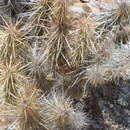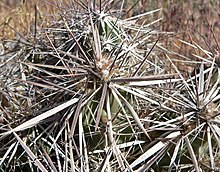en
names in breadcrumbs


Grusonia ist eine Pflanzengattung in der Familie der Kakteengewächse (Cactaceae). Der botanische Name der Gattung ehrt den deutschen Erfinder und Unternehmer Hermann Gruson.[1]
Die Pflanzen sind entweder kurzzylindrisch und gruppenbildend oder strauchig bzw. baumartig. Die Wurzeln sind in der Regel rübenartig, aber manchmal auch faserig. Die Triebe sind meist in zylindrische bis kugelige Segmente gegliedert, die manchmal gehöckerte Rippen aufweisen. Aus den Areolen entspringen Haare, Dornen und Glochiden.
Die rosafarbenen, purpurnen, gelben oder weißen Blüten erscheinen seitlich oder fast an der Triebspitze und öffnen sich am Tag.
Die trockenen oder fleischigen Früchte sind manchmal aufreißend und oft steril. Sie enthalten weißliche bis gelbliche Samen von etwa 2,5 bis 5 Millimeter Länge.
Die Gattung Grusonia ist im Südwesten der Vereinigten Staaten, der Halbinsel Baja California und einigen Bundesstaaten im Norden Mexikos verbreitet.
Die Typusart der Gattung ist Grusonia bradtiana (J.M.Coult.) Britton & Rose.
Die Gattung umfasst folgenden Arten:[2]
Synonyme der Gattung sind Corynopuntia F.M.Knuth (1936) und Marenopuntia Backeb. (1950).[3]
Die Gattung gliedert sich in die folgenden Untergattungen mit den Arten:[4]
Synonyme der Gattung sind Corynopuntia F.M.Knuth (1936), Microputia Daston (1947) und Marenopuntia Backeb. (1950).[5]
Der Gattungsname erschien das erste Mal in einem Gartenkatalog von Johannes Nicolai, der darin eine Art als Grusonia cereiformis aufführte. Karl Moritz Schumann erwähnte 1894[6] und 1896[7] in der Monatsschrift für Kakteenkunde die Art, gab jedoch keine gültige Beschreibung. Schumann schrieb den Namen Friedrich Reichenbach zu. Die erste gültige Beschreibung als Cereus bradtianus erfolgte durch John Merle Coulter nach von Anna B. Nickles gesammelten Exemplaren.[8] Die Erstbeschreibung der Gattung erfolgte erst 1919 durch Nathaniel Lord Britton und Joseph Nelson Rose.[9]
Eine erste grundlegende Bearbeitung der Gattung erfolgte 1973, als Harold Ernest Robinson sieben Arten der Gattung Corynopuntia zur Gattung Grusonia stellte.[10][11] Edward Frederick Anderson erweiterte die Anzahl der Arten 1999 ein weiteres Mal.[12]
Der taxonomische Status der Gattung ist nicht vollständig geklärt. Es gibt Untersuchungen, die darauf hindeuten, dass die Gattung Grusonia in die Gattung Cylindropuntia eingegliedert werden sollte.[13]
In David Hunts New Cactus Lexicon von 2006 umfasste die Gattung mit Grusonia bradtiana nur eine Art. Alle anderen Arten verweist er in die Gattung Corynopuntia.[14]
Grusonia ist eine Pflanzengattung in der Familie der Kakteengewächse (Cactaceae). Der botanische Name der Gattung ehrt den deutschen Erfinder und Unternehmer Hermann Gruson.
Grusonia is a genus of opuntioid cacti (family Cactaceae), originating from the North American Deserts in Southwest United States and northern Mexico, including Baja California. Authors differ on precise boundaries of the genus, which has been included in Cylindropuntia.[2] Corynopuntia, also known as club chollas (or "perritos" in Mexico), is now a synonym, with the genus originally being described by Knuth in 1935. Molecular phylogenetic studies suggest that it should be included in Grusonia, a view accepted by Plants of the World Online as of June 2021.
The name Corynopuntia comes from the Greek coryne, meaning ‘club’, and refers to the club-shaped branch segments, so "club opuntia", club cholla.
These opuntioid plants grow in low opuntioid cushions, consisting of rather ovoid or slightly clavate segments, from 1 up to 25 cm long, tuberculate, not ribbed, glabrous. Spines are strong, very prickly and dangerous, covered on their margins by fine denticles, with epidermal tunica (sheath) at the apex only. Flower generally yellow, few species have pink to deep magenta flower. Fruit narrowly obconic to ellipsoid, fleshy at first but soon drying, yellow to brownish, often stinky, generally full of glochids and spiny. Seed yellowish white to brownish, suborbicular or flattened. Most of the species belonging to Corynopuntia show a very similar morphology, apparently with few differences, so this genus was little studied. Recent in-depth field and lab researches are improving the knowledge about these plants, showing the existence of many undescribed species.[3][4][5][6][7][8] Whilst Corynopuntia members are morphologically similar one to each other, the mentioned research studies highlighted that wild club chollas rarely naturally hybridize when they grow sympatric.
The genus Corynopuntia was first set up in 1935[9] as a segregate from Opuntia, but was reduced to sectional rank by Benson in 1969 and slightly elevated again to a subgenus by Bravo in 1972. In 1999, Anderson included Corynopuntia in his enlarged concept of Grusonia.[10] Pioneering DNA work by Dickie in 1997, subsequent molecular data from Wallace and Dickie (2002)[11] and Griffith (2003),[12] and seed micromorphology studies by Stuppy (2002),[13] suggested that Corynopuntia should be reinstated as a distinct genus. This was accepted by the Cactaceae Consensus Group in 2006.[14] However, a 2016 molecular phylogenetic study of the tribe Cylindropuntieae showed that when separated, Corynopuntia and Grusonia were polyphyletic, and so combined them as Grusonia.[15] This is accepted by Plants of the World Online as of June 2021.[16]
The members of the genus Corynopuntia are native of South-Western United States (California, Arizona, Nevada, New Mexico and Texas) and Northern Mexico (States of Baja California, Baja California Sur, Sonora, Chihuahua, Coahuila, Nuevo Leon, Durango, Zacatecas, San Luis Potosì, Tamaulipas), from 60 up to 2000 m above the sea level.
Club chollas grow generally in very dry areas, on flats or gentle slopes, fully exposed to the sunlight or sometimes under sparse bushes. Depending on the species, they grow on sandy, loamy or gravelly soil. The stem segments of several species readily break off when touched: this is an important method of vegetative reproduction for these cacti, since the finely toothed spines stick to animal skin or fur, then the segment can be transported even for miles. The barbed spines can remain embedded in the skin, causing discomfort and sometimes injury.
Species of the genus Grusonia according to Plants of the World Online As of January 2023:[17]
 Grusonia parishiorum
Grusonia parishiorum Grusonia is a genus of opuntioid cacti (family Cactaceae), originating from the North American Deserts in Southwest United States and northern Mexico, including Baja California. Authors differ on precise boundaries of the genus, which has been included in Cylindropuntia. Corynopuntia, also known as club chollas (or "perritos" in Mexico), is now a synonym, with the genus originally being described by Knuth in 1935. Molecular phylogenetic studies suggest that it should be included in Grusonia, a view accepted by Plants of the World Online as of June 2021.
Grusonia es un género de plantas fanerógamas perteneciente a la familia Cactaceae. Comprende 8 especies descritas y de estas, solo 3 aceptadas.[1]
Algunos autores difieren en los límites precisos del género, donde algunas especies han sido incluido en Cylindropuntia.[2]
El género fue descrito por Karl Moritz Schumann y publicado en Monatsschrift für Kakteenkunde 4: 110. 1894.[3]
Grusonia: nombre genérico que fue otorgado en honor del inventor y empresario alemán Hermann Gruson.[4]
A continuación se brinda un listado de las especies del género Grusonia aceptadas hasta abril de 2015, ordenadas alfabéticamente. Para cada una se indica el nombre binomial seguido del autor, abreviado según las convenciones y usos.
Grusonia es un género de plantas fanerógamas perteneciente a la familia Cactaceae. Comprende 8 especies descritas y de estas, solo 3 aceptadas.
Algunos autores difieren en los límites precisos del género, donde algunas especies han sido incluido en Cylindropuntia.
Grusonia on opuntioille (Opuntia) läheinen, 17-lajinen, pohjoisamerikkalainen kaktuskasvisuku. Se on saanut nimensä saksalaisen kasvien keräilijän Herman Grusonin mukaan.[1]
Grusonia-kaktukset ovat joko matalakasvuisia ja mätästäviä tai pensasmaisia tai puumaisia. Varret ovat tavallisesti nivelikkäät, toisinaan uurteiset ja nystyiset. Lehdet ovat pieniä, liereitä, varhain karisevia. Areoleissa on karvoja, väkäsekkäitä glokidioita ja piikkejä, joissa ei yleensä ole paperimaisia tuppia kuten on säännöllisesti lieriöopuntioilla (Cylindropuntia). Juuret ovat mukulamaisia, toisinaan rihmamaisia.[2]
Kukat sijaitsevat varren sivulla tai melkein kärjessä, ovat väriltään vaaleanpunaisia, purppuraisia, keltaisia tai valkoisia. Kasvit kukkivat päivällä. Hedelmä on kuiva tai mehevä, joskus avautuva, usein siemenetön. Siemenet ovat valkeahkoja tai kellertäviä.[3]
Grusonia-suku kasvaa Yhdysvaltojen lounaisosassa, Kalifornian niemimaalla ja Pohjois-Meksikossa.[4]
Opuntioideae-alaheimon DNA-sekvenssi-, siementutkimukset sekä morfologiset ja sytologiset analyysit ovat valaisseet huomattavasti tätä opuntioiden sukulaisten ryhmää. On tullut selväksi, että laajasti ymmärretty Opuntia-suku on polyfyleettinen, joten se on jaettava pienemmiksi monofyleettisiksi suvuiksi. Kuitenkin monien näin muodostuneiden sukujen rajat ovat jääneet epäselviksi, mikä koskee myös Grusonia-sukua. Kansainvälinen eri tutkijoista koostuva International Cactaceae Systematics Group synonymisoi entiset suvut Corynopuntia, Marenopuntia ja Micropuntia suvun Grusonia kanssa. Näin vm. sukuun sisältyy seuraavat 17 lajia.[5]
Anderson E. F. 2001: The Cactus Family. - Timber Press. Portland, Oregon. ISBN 0-88192-498-9
Grusonia on opuntioille (Opuntia) läheinen, 17-lajinen, pohjoisamerikkalainen kaktuskasvisuku. Se on saanut nimensä saksalaisen kasvien keräilijän Herman Grusonin mukaan.
Grusonia est un genre de la famille des cactus.
Il porte le nom d'Hermann Gruson, cactophile allemand.
Avec l'image ci-dessus, on voit qu'il est proche du genre Opuntia avec un sous-genre duquel il est parfois confondu.
Il est originaire du sud-ouest des États-Unis et du nord du Mexique, incluant la Basse-Californie.
Les plantes sont de forme colonnaire, souvent buissonnantes avec de fortes épines. Elles présentent parfois des feuilles minuscules qui tombent dans l'année.
Comme la plupart des cactus, ils ont besoin d'un sol sableux bien drainé pauvre en humus, avec des arrosage réguliers de mars à septembre. Et un hivernage totalement au sec à une température ne descendant pas en dessous de 10 °C.
Multiplication facile par bouturage ou par semis.
Grusonia est un genre de la famille des cactus.
Il porte le nom d'Hermann Gruson, cactophile allemand.
Avec l'image ci-dessus, on voit qu'il est proche du genre Opuntia avec un sous-genre duquel il est parfois confondu.
Il est originaire du sud-ouest des États-Unis et du nord du Mexique, incluant la Basse-Californie.
Les plantes sont de forme colonnaire, souvent buissonnantes avec de fortes épines. Elles présentent parfois des feuilles minuscules qui tombent dans l'année.
Grusonia K.Schum. è un genere di piante della famiglia delle Cactacee.[1]
Il nome del genere ricorda l'inventore e imprenditore tedesco Hermann Gruson (1821-1895), un grande appassionato e collezionista di piante grasse.
Hanno fusti cilindrici che non raggiungono altezze apprezzabili, presentano scanalature longitudinali da dove si sviluppano areole con al centro un ciuffo di spinette che cadono al solo contatto.
Le piante giovani presentano alcune foglioline che cadono prestissimo.
Il genere è diffuso negli Stati Uniti sud-orientali (California, Arizona, Nevada, New Mexico, Texas, Utah) e nel Messico.[1]
Il genere comprende le seguenti specie:[1]
Il terriccio necessario per la coltivazione è composto da terra fibrosa, torba granulosa, sabbia con aggiunta di sabbia grossolana. Le piante andranno rinvasate almeno ogni due anni all'inizio della primavera.
La posizione richiesta è soleggiata; le annaffiature dovranno essere regolari nel periodo che va da marzo a settembre, mentre andranno gradualmente ridotte fino a venire sospese del tutto nei mesi invernali.
La temperatura a cui dovranno essere esposte nel periodo invernale non deve essere inferiore ai 10 °C.
La moltiplicazione avviene:
Grusonia K.Schum. è un genere di piante della famiglia delle Cactacee.
Il nome del genere ricorda l'inventore e imprenditore tedesco Hermann Gruson (1821-1895), un grande appassionato e collezionista di piante grasse.
Grusonia is een geslacht van cactussen. De soorten komen voor in het zuidwesten van de Verenigde Staten, noordelijk Mexico en Baja California.
Grusonia is een geslacht van cactussen. De soorten komen voor in het zuidwesten van de Verenigde Staten, noordelijk Mexico en Baja California.
По информации базы данных The Plant List, род включает 3 вида[2]:
По информации базы данных The Plant List, род включает 3 вида:
Grusonia bradtiana (Coult.) Britton & Rose Grusonia densispina (Ralston & Hilsenb.) Pinkava Grusonia robertsii Rebman